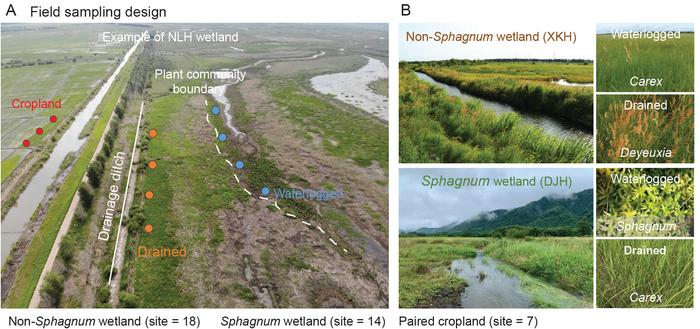
The Complex Interplay Between Wetland Drainage and Soil Carbon Dynamics
Wetlands represent vital ecosystems found globally, yet their health is increasingly threatened by anthropogenic activities, particularly drainage. As the pressure mounts to convert wetlands for agricultural and urban development, understanding the implications of such actions on carbon dynamics becomes critical. Recent research led by a team of scientists from the Institute of Botany, Chinese Academy of Sciences, delves into this complex interaction, focusing on the effects of drainage on soil organic carbon (SOC) sequestration in wetland environments across China.
Drained wetlands serve as a key site for examining soil carbon dynamics because they transform the ecological functions of these areas drastically. Historically, wetlands have acted as significant carbon sinks, storing between 600 to 1000 gigatons of soil carbon, thereby contributing to climate regulation. However, when these ecosystems are drained, their ability to sequester carbon is compromised, raising essential questions about carbon loss and transformation processes within these environments.
Draining wetlands initiates a series of biogeochemical changes to the soil, profoundly impacting the stored carbon. Prior studies hinted at intriguing developments, such as the potential formation of metal-bound organic carbon (bound OC), which occurs through the oxidation of ferrous iron. This process could reshape how SOC accumulates in drained wetlands, but the overall impacts and patterns remain poorly understood, particularly across different wetland types, which has been the impetus for this comprehensive study.
Conducting a nationwide pairwise survey across 32 distinct wetlands in China, including both Sphagnum and non-Sphagnum varieties, the research team implemented a meticulous approach. Each site was designed to compare pairs of drained and waterlogged areas virtually, providing rigorous data on how different wetlands responded to prolonged drainage conditions over 15 to 55 years. Through this dual analysis, the scientists aimed to shed light on the contrasting responses of SOC dynamics in different wetland environments.
The findings of the study were both revealing and concerning. Notably, the research indicated that non-Sphagnum wetlands exhibited a significant increase in the stability of metal-bound organic carbon following long-term drainage, attributed primarily to the influx of reactive metal (hydr)oxides that facilitate this process. This stabilization effectively enhanced carbon retention in drained soils, suggesting that non-Sphagnum wetlands may adapt better to drainage conditions than their Sphagnum counterparts.
In stark contrast, the Sphagnum wetlands displayed a decline in bound OC following drainage. The research found evidence that this loss corresponded with an ecological shift due to the replacement of Sphagnum, a species, often referred to as a ‘rust engineer’, by herbaceous plants. This shift fundamentally alters the soil composition and the associated carbon stabilization mechanisms, raising alarms about the resilience of Sphagnum wetlands in the face of ongoing drainage practices.
Both SOC and bound OC content dropped across multiple soil layers within drained Sphagnum wetlands, underscoring the detrimental effects of drainage. In comparison, non-Sphagnum wetlands reported an increase in SOC, paired with a burgeoning population of reactive metals within the soil matrix. This nuanced response pattern underscores a pivotal learning point: while some wetlands may benefit from drainage-induced transformations, others suffer grievously, presenting critical implications for ecosystem management and climate change mitigation strategies.
The dissociation observed between Sphagnum and non-Sphagnum wetlands suggests that the benefits of drainage on carbon sequestration may not be universally applicable. Instead, these findings urge a reevaluation of current land management practices. Effective conservation strategies must account for the differing trajectories of carbon dynamics in variable wetland habitats, emphasizing that not all drainage leads to similar ecological outcomes.
As researchers delve deeper into this topic, the possibility of integrating these findings into predictive models becomes increasingly relevant. By considering how shifting hydrological regimes impact SOC dynamics, models can be refined, allowing for improved projections of carbon dynamics in response to climate change pressures.
Moreover, understanding the mechanisms underpinning these responses may foster the development of management practices that minimize carbon loss and enhance the longevity and health of wetland ecosystems. The findings illuminate the crucial balance required in managing wetlands, where they can function to fulfill both ecological integrity and societal needs.
The implications of this research extend beyond mere academic curiosity; they resonate on a global scale as ecosystems worldwide face similar threats. Policymakers, conservationists, and agricultural stakeholders must collaboratively reflect on such studies to reshape practices that prioritize the preservation of wetlands as critical biomes in the fight against climate change.
To conclude, the study elucidates the stark ramifications of wetland drainage on soil carbon dynamics, emphasizing that these effects are profoundly contingent upon wetland types. As the research community continues to amplify the conversation surrounding wetland health, these findings will undoubtedly inform future strategies to protect and manage these precious ecosystems.
Subject of Research: The impact of drainage on soil carbon dynamics in wetlands.
Article Title: Metallic protection of soil carbon: Divergent drainage effects in Sphagnum vs. non-Sphagnum wetlands.
News Publication Date: Not specified.
Web References: Not specified.
References: Not specified.
Image Credits: ©Science China Press.
Keywords
Soil carbon dynamics, wetlands, drainage, carbon sequestration, *Sphagnum*, metal-bound organic carbon, climate change, ecological management.





